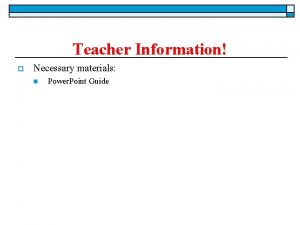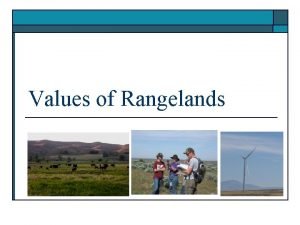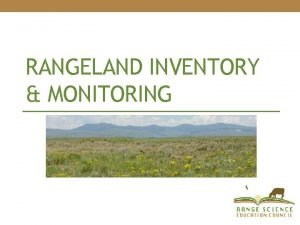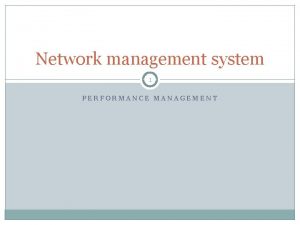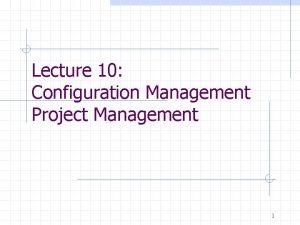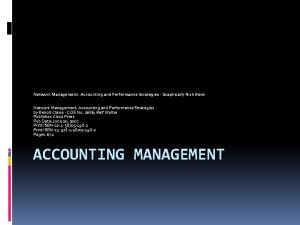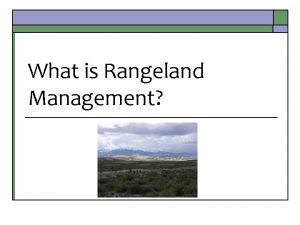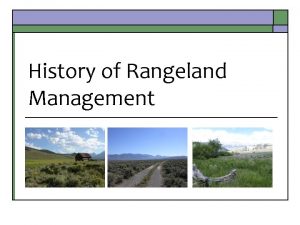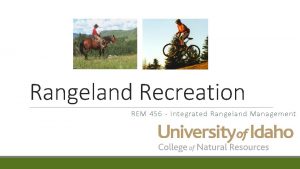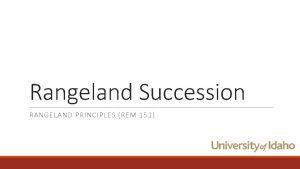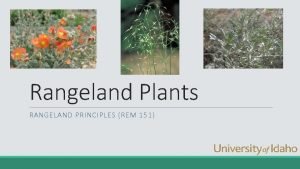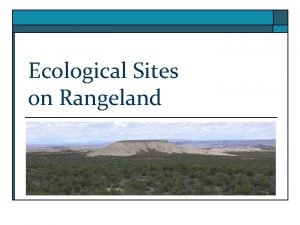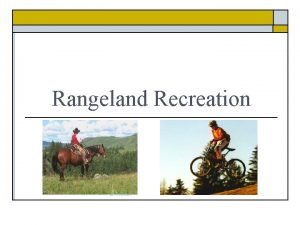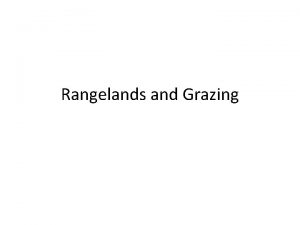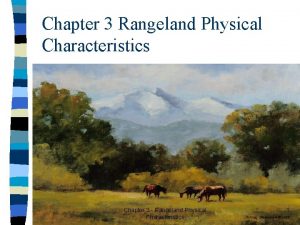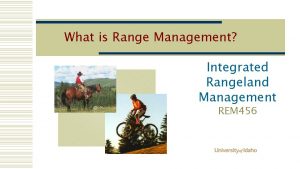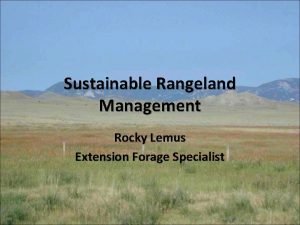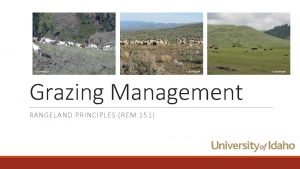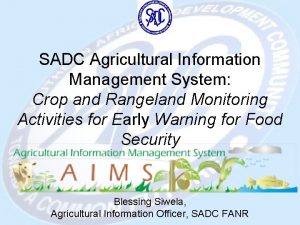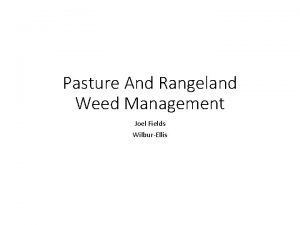What is Rangeland Management Rangeland Management is o


















- Slides: 18

What is Rangeland Management?

Rangeland Management is: o o The use and stewardship of rangeland resources to meet goals and desires of humans. A Planning Process CURRENT o FUTURE Planning examines different alternatives to see which is the “best “ future world.

What is “Best” o It depends on your point of view. n n n Preservationists Conservationists Utilitarianisms Pragmatists Etc. etc.

What is “Best” o Preservationists – n n o Conservationists – n n o Emphasize protecting large areas of land from mining, timber, grazing & development so they can be enjoyed by present and future generations. Founders of the preservation movement were John Muir and Aldo Leopold. View land as a resource to be used now to enhance economic growth. But, protected from degradation by efficient management, based on scientific principles, for sustained yield and multiple use. Early conservationists were T. R. Roosevelt, Gifford Pinchot, and John Wesley Powell. Utilitarianists – n View land as a substrate for saleable products. Management is based on land manipulation and exogenous inputs (e. g. , fertilizer or herbicides) are usually required to keep production at an optimum level.

Rangeland Management Source of Decision? ? ? CURRENT ? ? FUTURE

Rangeland Management Source of Decision? information CURRENT tradition hunches guesses FUTURE

Why do we need science? o o Mangers must integrate scientific knowledge with ideas, hunches, traditions, etc. , to make wise decisions. To understand the physical, biological, and social processes that affect rangelands. To discover principles on which to base the wise use of rangelands. Others?

Rangeland Management What kinds of decisions do we make? CURRENT • Political – laws and policies • Economic – buy, sell, • Direct actions FUTURE

What is the role of Education? o o o Convey what is known to society Stop non-objective views Lead to wise land use discussion and support for actions.

Rangeland Management is: o The use and stewardship of rangeland resources to meet goals and desires of humans. o What do people want from rangelands?

Why are rangelands important? Livestock Production Forage Recreation Wildlife Habitat Native Plants Water Open Space Energy Minerals

Rangeland Management is: o The use and stewardship of rangeland resources to meet goals and desires of humans. o What tools do we have for Range Management?

Ecological Services & Resources • forage for livestock Forces & Impacts Fire on Invasi • wildlife habitat • watershed management • biodiversity conservation • open space • carbon sequestration vory Climate i b r e H Hu ses man U e Chang nt, opme Devel tations, en Fragm reation & Rec Rangelands Grasslands, Shrublands, Woodlands

Ecological Services & Resources • forage for livestock Forces & Impacts Fire on Invasi • wildlife habitat • watershed management • biodiversity conservation • open space • carbon sequestration vory Climate i b r e H Hu ses man U e Chang nt, opme Devel tations, en Fragm reation & Rec Rangelands Grasslands, Shrublands, Woodlands Fir We Mg e d mt e Human Impacts Tools for Liv e Gra stock zin g Restora t Rehabi ion/ litation Stewardship

Tools of Range Management o o Fire Livestock grazing Integrated weed management Human impacts n n o Recreation Development Restoration & rehabilitation

Rangeland Management – Basic Concepts o Rangelands are renewable resources; they can produce on a sustained yield basis if properly managed. o Rangeland must be managed to maintain soil and water quality and health and basic biogeochemical cycles. o Rangelands are managed by extensive and ecological principles, not intensive and agronomic principles.

Rangeland Management – Basic Concepts o Rangelands produce a variety of products (e. g. , forage, recreation, water) therefore principles of multiple use are important in range management. o Many important public concerns on rangeland happen across multiple ownerships (i. e. , fire, water quality, weeds, open space). o You can’t please all the people all the time. What one person wants my not meet the desires of plans of another.

Principles of Rangeland Management o Rangelands change through succession and disturbance. All we can really do as managers is apply, control, or respond to disturbance based on our knowledge of succession. o The only constant on rangeland is CHANGE. Conditions change from place to place (spatially) and time to time (temporally). We need to understand accept change. o If you do nothing the land will probably not return to some pre-human paradise.
 Rangeland management ppt
Rangeland management ppt 5 importance of rangeland
5 importance of rangeland Smart goals examples for inventory control
Smart goals examples for inventory control Idaho rangeland resource commission
Idaho rangeland resource commission Top management and middle management
Top management and middle management Management pyramid
Management pyramid Top level management
Top level management Time management human resources
Time management human resources Performance management network definition
Performance management network definition Managing assets vs asset management
Managing assets vs asset management Configuration management in project management
Configuration management in project management Functional components of ecrm
Functional components of ecrm Retail store organizational structure
Retail store organizational structure Basic principles of cost management in project management
Basic principles of cost management in project management Behavioral management theory
Behavioral management theory Network accounting management
Network accounting management Hrm vs hrd
Hrm vs hrd Saint seiya soul of gold
Saint seiya soul of gold Quality management in operations management
Quality management in operations management
